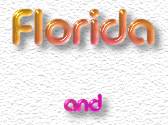It's
been questioned by some whether Florida
is
a true Southern state
-- I was
born and raised in Florida, I still live in Florida, and I've always been
a Southerner, so I guess that proves it is.
-- My Daddy
was born in Tennessee and my Mama in Florida ... Mama and I considered
ourselves as much a Southerner as Daddy. Daddy wouldn't consider
living anywhere but the South and he lived in Florida for 49 years.
-- And one
more thing, Florida is about as far south as one can go and still remain
on dry land.

Gulf
of Mexico - Destin, Florida
in
the northwest panhandle of Florida
Photo
by E. Rhea Sallinger ©2002
All
Rights Reserved
*******
State Motto:
“In God We Trust”
from inscription on Great Seal, as directed by 1868 Legislature

*******
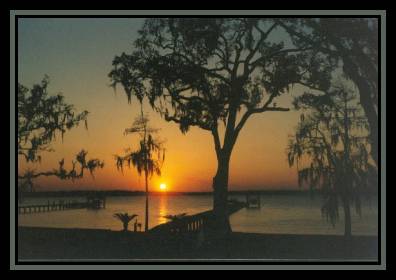
St. Johns River, Jacksonville,
Florida
Photo
by JCW Design ©2001
All
Rights Reserved
Florida
was the first state to be named and some people say
its
name is even older than the name "America"
Florida is the land
of flowers. Florida’s name was inspired by flowers. Spanish
explorer, Juan Ponce de León, named it La Florida on April
2, 1513. The name honors Pasqua de Flores, the Spanish Feast of the Flowers
at Eastertime.
In keeping with its
name, Florida’s state seal depicts an Indian woman strewing flowers on
the ground. The woman represents Florida’s native tribes.
-- *After
the Compromise of 1850, Florida joined the other Deep South states on the
slow road to succession. At the Southern Democratic Convention in
June of 1859, the Florida delegation dominated by planters was the only
state to join South Carolina to threaten secession if the Democrats don't
openly oppose the antislavery forces. When the National Democratic
Convention selected Stephen Douglas of Illinois and a moderate platform,
Florida's delegation backed a Southern Democratic candidate for President
as the solution. With the Democrats running three candidates in 1860,
Abraham Lincoln and the Republicans won the White House and took control
of dozens of Congressional seats held in the North and Midwest by Democrats.
South Carolina did not wait to discover what the Republicans would do with
Congress, but elected to vote on secession and called for votes in the
other slave states. Florida's Governor Perry called a convention
of secession in January 10, 1861 in Tallahassee to decide upon Florida's
future. Of the 69 delegates, 58 were slave owners. Many others
opposed secession as unconstitutional and tried to delay the vote, stating
that Florida should wait for the decision of Alabama and Georgia.
Only seven delegates voted to delay an early secession vote. Florida
voted to secede as soon as the news arrived from South Carolina.
Florida was the third state to leave the Union, and within a month it joined
with other southern states to form the Confederate States of America.*
Ordinance of Secession.
We, the People of the State of Florida
in Convention assembled, do solemnly ordain,
publish and declare: That the State of
Florida hereby withdraws herself from the
Confederacy of States existing under the
name of the United States of America, and
from the existing Government of
said States; and that all political connection between
her and the Government of said States
ought to be and the same is hereby totally
annulled, and said union of States dissolved;
and the State of Florida is hereby
declared a Sovereign and Independent Nation;
and that all ordinances heretofore
adopted in so far as they create or recognize
said Union are rescinded; and all laws or
parts of laws in force in this State,
in so far as they recognize or assent to said
Union be and they are hereby repealed.
Done in open Convention, January
10th, A.D. 1861
-- *By
February, seven Southern states had seceded and elected to meet in Montgomery,
Alabama to form the Confederate States of America. They would not
wait for Virginia to secede or wait for Lincoln's inauguration to find
out what Republican policies would be adopted. Governor Perry ordered
the seizure of Federal arsenals in St. Augustine, Fernandiana, and Chattahoochee,
to provide the state militia with weapons. President Lincoln was
determined to preserve the Union and to maintain whatever Federal sites
were left in the South. The firing on Union supplies at Fort Sumter
in the Charleston, South Carolina Harbor officially placed the North and
the South in a Civil War. Virginia left the Union and because they
were the richest and largest Confederate state, the capital was switched
to Richmond. Florida was requested to recruit 5,000 soldiers.
In three months, Florida had 6,772 volunteers. The majority of the
South's volunteers were small farmers who owned no slaves. Before
the end of the conflict, about 15,000 Floridians out of a population of
just 78,000 whites fought in the Civil War. Some 1,209 whites and
1,044 African-Americans from Florida served in the Union Army. Of
the state's 15,000 soldiers, one third would fail to return home.
Everyone from planter to slave felt the impact of the Civil War.
Despite the fears that slaves would rebel, most slaves remained on the
plantation, often assuming all roles of field and barn management.
While many slaves headed to Jacksonville to join the Union Army, others
were hired by the State of Florida to rebuild roads and bridges.*
*******
It's been said
that Florida was so far south in the Civil War,
it had it's own
Civil War.

Florida
Secession Flag 1861
| **Helen
Broward, of Broward's Neck in Duval County, and other southern women who
supported the secessionist cause made and presented this flag to Florida
Governor Madison S. Perry. It was unfurled by Governor-elect John Milton
on the east porch of the state capitol when the delegates signed Florida's
Ordinance of Secession on January 11, 1861. The three large stars represent
the first three states to leave the Union: South Carolina, Mississippi,
and Florida. The flag's motto, "The Rights of the South at All Hazards!",
echoes the uncompromising position of southern supporters on the eve of
the Civil War. The banner reportedly hung above the speaker's desk in the
Florida House of Representatives throughout the war.
At the war's end, the banner still hung in the capitol and reportedly was
taken as a trophy by a Union army officer during the postwar occupation
of the building. It is recorded that this officer later felt guilty about
taking the banner and gave it to a Mrs. Hasson, the wife of a military
doctor, to return it to the state. The Hassons moved to the western U.S.
shortly after this incident. It was not until 1911 that Mrs. Hasson sent
the flag to a Florida member of the United Daughters of the Confederacy,
who then returned it to the State of Florida.** |
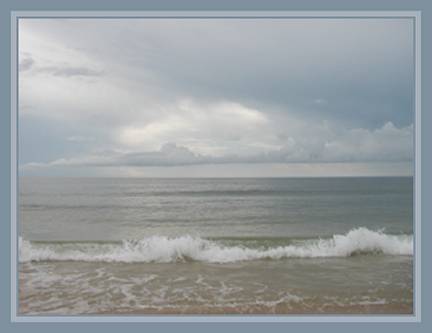
Mexico
Beach, on the Gulf of Mexico
in
the northwest panhandle of Florida
Photo
by E. Rhea Sallinger ©2002
All
Rights Reserved
 FLORIDA
FACTS FLORIDA
FACTS
-- First
permanent European settlement - 1565, St. Augustine, by Spain
-- Admitted
to U.S. as state - March 3, 1845 (27th state)
-- Capital
- Tallahassee
-- Population
1999 - 15,982,378 (1990 was 12,937,926)
-- Number
of Counties - 67
-- Total
Area - 58,560 square miles -- Total Land
Area: 54,252 sq.miles -- Total
Water Area: 4,308 sq. miles
-- Length
North & South - 447 miles (St. Marys River to Key West)
-- Width
East & West - 361 miles (Atlantic Ocean to Perdido River)
-- Distance
from Pensacola to Key West - 792 miles (by road)
-- Highest
Natural Point - 345 feet near Lakewood in northeast Walton
County
-- Coastline
- 1,197 statute miles
-- Tidal
shoreline (general) - 2,276 statute miles
--
Beaches - 663 miles
-- Longest
River - St. Johns River, 273 miles
-- Largest
Lake - Lake Okeechobee, 700 square miles
-- Number
of lakes (greater than 10 acres) - about 7,700
-- Number
of first-magnitude springs - 27
-- Number
of islands (greater than 10 acres) - about 4,500

Destin,
Florida
in
the northwest panhandle of Florida
Photo
by James Humphreys ©2002
All
Rights Reserved
 FLORIDA
SYMBOLS FLORIDA
SYMBOLS
-
STATE BIRD -
Mockingbird
A year-round Florida
resident, the mockingbird was
designated as the
State Bird by the 1927 legislative session.
-
STATE SONG -
"The
Swanee River"
Old
Folks at Home
Stephen C. Foster,
one of America's best-loved musical story tellers, wrote "The Swanee River
(Old Folks at Home)" in 1851. A memorial center at White Springs honors
Foster, who authored about 200 songs during his career, although he had
never visited Florida. The Suwannee River flows southerly from the
Okeefenokee Swamp in Georgia to the Gulf of Mexico in Florida, topographically
slicing the Florida panhandle from the rest of the state.
Way down upon
de Swanee Ribber,
Far, far away,
Dere's wha my
heart is turning ebber,
Dere's wha de
old folks stay.
All up and down
de whole creation
Sadly I roam,
Still longing
for de old plantation,
And for
de old folks at home.
(Chorus)
All de world am
sad and dreary,
Eb-rywhere I
roam;
Oh, darkeys,
how my heart grows weary,
Far from de old
folks at home!
(2nd verse)
All round
de little farm I wandered
When I was young,
Den many happy
days I squandered,
Many de songs
I sung.
When I was playing
wid my brudder
Happy was I;
Oh, take me to
my kind old mudder!
Dere let
me live and die.
(3rd Verse)
One little hut
among de bushes,
One dat I love
Still sadly to
my memory rushes,
No matter where
I rove.
When will I see
de bees a-humming
All round de
comb?
When will
I hear de banjo strumming,
Down in my good
old home?
In 1935, "The
Swanee River" became the official State Song,
replacing "Florida,
My Florida," which had been adopted as the State Song in 1913.
Florida, My Florida
(Sung to the tune of "Maryland,
My Maryland")
Land of my birth, bright sunkissed land,
Florida, my Florida.
Laded by the Gulf and Ocean grand,
Florida, my Florida.
Of all the States in East or West,
Unto my heart thou art the best
Here may I live, here may I rest
Florida, my Florida.
The golden fruit the world outshines
Florida, my Florida,
Thy gardens and thy phosphate
mines,
Florida, my Florida,
In country, town, or hills and dells,
Florida, my Florida,
The rythmic chimes of the school bells
Florida, my Florida,
Will call thy children day by day
To learn to walk the patriot's way
Firmly to stand for thee for aye
Florida, my Florida.
Yield their rich store of good supply,
To still the voice of hunger's
cry—
For thee we'll live, for thee
we'll die
Florida, my Florida.
Written in 1894 by Rev. Dr. C. V.
Waugh, a professor of languages at the Florida Agricultural College at
Lake City, "Florida, My Florida" was adopted in the 1913 Legislature
as Florida's State Song until 1935, when "Swanee River" became the official
State Song.
*******

St.
Andrews State Park, Panama City, Florida
on
the Gulf of Mexico
in
the northwest panhandle of Florida
Photo
by E. Rhea Sallinger ©2002
All
Rights Reserved
*******
Like the Spanish
explorers who discovered Florida, its state flower is not native to North
America but is probably native to China.
The waxy, white blossoms
of the orange tree are very fragrant. Tons of Florida orange
blossoms were once shipped to weddings across the country.
In 1967, Florida
adopted a state beverage, orange juice.
Concentrated orange
juice was developed during World War II. After the war, a frozen
concentrate was developed and orange juice production exploded into a multi-billion
dollar industry.
Some of Florida’s
biggest events celebrate its citrus industry. These include the Orange
Blossom Festival and the Orange Bowl.
-
State Flower -
Orange
Blossom
The orange blossom
was designated the State Flower
by the Nov.15, 1909
Legislature.
-
State Wildflower -
Coreopsis
There are about
twelve varieties of Coreopsis that grow in Florida.
The flowers’ yellow
petals remind one of the nickname "Sunshine State"
Plants of the genus
Coreopsis
belong to the sunflower family
and are relatives
of Kansas’ state flower.
-
State Tree -
Sabal
Palmetto Palm
The 1953 Legislature
designated the Sabal Palmetto Palm as the State Tree. This palm is the
most widely distributed in the state and possesses a majesty that sets
it apart from other trees. The 1970 Florida Legislature mandated that the
sabal palm should replace the cocoa palm on the State Seal. Some
people say the "cocoa" tree was actually a coconut, another palm not native
to Florida. Seminole Indians thatched their homes with sabal palmetto
leaves. They also ate the bud. Early Florida settlers also got food from
the Sabal palm, or “swamp cabbage.” They also made forts out of its wood,
which withstood arrows, bullets, and cannonballs. In fact, South Carolina
adopted the sabal palmetto as its state tree because of its service in
a famous battle.
-
State Animal -

Florida
Panther
This most endangered
of all Florida's symbols is its State Animal, the Florida Panther (Felis
concolor coryi), which was chosen in 1982 by a vote of students throughout
the state. With an estimated wild population of only 30 to 50 animals,
Florida panthers are perhaps the rarest and most elusive native animal
of the region. Known locally as panthers, these large, tawny cats are actually
a subspecies of mountain lion, an animal that once had the broadest distribution
of any terrestrial mammal in the Western Hemisphere. After two centuries
of intensive hunting and habitat loss, mountain lions are still found in
many western states, but the only known population east of the Mississippi
River now makes its last stand in south Florida.
-
State Seal -
.
In 1868, Florida's
newly adopted State Constitution had directed that:"The Legislature shall,
at the first session, adopt a seal for the state, and such seal shall be
the size of an American silver dollar, but said seal shall not again be
changed after its adoption by the Legislature." In 1985 the Secretary of
State presented the revised Great Seal of the State of Florida to
the Governor and the Cabinet. The previous State Seal had several
errors which were corrected in in the 1985 Seal. This revised Seal has
a Seminole Indian woman rather than a Western Plains Indian, the
steamboat is more accurate, and the "cocoa" palm has been changed to a
sabal palm as the Legislature prescribed in 1970.
-
State Flag -
Many flags have flown
over Florida since Juan Ponce de León landed in 1513. Among
them have been the
flags of five sovereign nations: Spain, France, Great Britain, the
United States, and
the Confederate States of America. Numerous other unofficial flags
also have been flown
on the peninsula at one time or another.
A joint resolution
of the legislature in 1899, approved by state voters in1900, made the current
State Flag the official banner of Florida. The official specifications
for the flag are - "The State Flag shall conform with standard commercial
sizes and be of the following portions and descriptions: The seal of the
state, in diameter one-half the hoist, shall occupy the center of a white
ground. Red bars, in width one-fifth the hoist, shall extend from each
corner towards the center, to the outer rim of the seal."
Between 1868 and
1900, Florida's state flag consisted of a white field with the state seal
in the center. During the late 1890s, Governor Francis P. Fleming suggested
that a red cross be added, so that the banner did not appear to be a white
flag of truce or surrender when hanging still on a flagpole.
FLAGS
FLOWN OVER FLORIDA

|
Spanish Discovery
- 1513
Spain did not have
a national flag when Juan Ponce de Leon first came to Florida in 1513.
At the time, the Spanish royal banner was the flag of Castile and Leon.
This flag has become associated with early Spanish exploration of the Americas,
although it is not known whether this banner was actually carried ashore
in Florida by Ponce de Leon. |

|
French Attempts
at Settlement 1564
In 1564, the French
established a short-lived settlement near Jacksonville at the mouth of
the St. Johns River. During this time there was no single official
flag for France. Their flag may have had a blue background with the
gold fleurs-de-lys. The French also occupied Pensacola from 1719
to 1722 during the War of the Quadruple Alliance.
|

|
First Spanish
Occupation 1565-1793 - Cross of Burgundy
The Cross of Burgundy
represented Spanish rule in Florida from 1565-1793. The X-shaped
cross symbolized the rough branches of the trees on which Saint Andrew,
the patron saint of Burgundy, was crucified. |

|
British Union
Flag - 1763-1784
The red Cross of
St. George, the patron saint of England, was the major element of the British
flag. In combination with the white Scottish Cross of St. Andrew,
it formed the Union flag. This flag flew over Florida from 1763 until
1784. |

|
Second Spanish
Occupation - Spanish National Flag - 1784-1821
Charles III created
this Spanish flag in 1785. It flew over Florida until the United
States took official possession of the territory in 1821. |

|
State of Muskogee
- 1799-1803
Englishman William
Augustus Bowles designed this flag after a congress of Creeks and Seminoles
elected him director general of the State of Muskogee in 1799. The
capital of this state was the Indian village of Mikasuke, near Tallahassee.
Bowles was captured and turned over to Spanish authorities in 1803, later
dying in a Havana prison. The State of Muskogee came to an end. |

|
Republic of West
Florida - 1810
This flag flew over
the Free and Independent State of West Florida Sept. 23 - Dec. 6, 1810,
covering the area below the thirty-first parallel between the Mississippi
and Pearl Rivers, now a part of Louisiana.
This flag later became
the unofficial ensign of the South in 1860-61 and inspired Harry McCarthy
to compose the song, "The Bonnie Blue Flag." |

|
Patriots Flag
- 1812
On March 13, 1812,
a group of 70 people from Georgia and nine from Florida crossed the St.
Marys River to Amelia Island to establish the "Territory of East Florida."
They read a manifesto and raised a flag with a Latin inscription, meaning
"The safety of the people, the supreme law." President James Madison
refused to acknowledge their claim and the movement failed. |

|
Green Cross Flag - 1817
American citizens, desiring the independence
of Florida, in 1817 sponsored an expedition into the Spanish territory
led by Gregor MacGregor, a veteran of Latin American revolutions.
The group occupied Amelia Island on June 20 and raised a white flag with
a green cross. Four months later they were forced to leave. |

|
The 27th State
- July 4, 1845
The United States
government admitted Florida as the 27th state on March 3, 1845. By
law, new stars were added to the national flag on the 4th of July following
the admission of each new state. The 27th star was added for Florida
on July 4, 1845. |

|
Proposed State
Flag - 1845
On March 3, 1845,
Florida became the 27th state. Citizens of Tallahassee presented
incoming Governor William D. Moseley with a flag that flew at his inauguration.
Because of a controversy surrounding its motto, it never became an official
state flag.
(The flag shown here
is reconstructed from a written description). |

|
Florida Secession
Banner - 1861
Unofficial "secession"
flags were flying in many parts of the state even before Florida left the
Union. "The Ladies of Broward's Neck" in Duval County presented this
flag to Governor Madison Starke Perry. It was displayed at the Capitol
when the Ordinance of Secession was signed on January 11, 1861. |

|
Colonel Chase's
Lone Star Flag - 1861
During the crisis
preceding the outbreak of the Civil War, state forces took control of the
federal forts and navy yard at Pensacola. At the Pensacola Navy Yard,
Colonel William H. Chase, commander of Florida troops, raised this flag,
which had the same design as that used by the Republic of Texas Navy 1836-1845. |
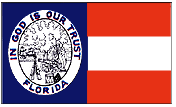
|
Florida's First
Official Flag - 1861
After Florida seceded
from the Union in January 1861, several unofficial flags flew over the
state. The general assembly passed an act directing Governor Perry
to adopt "an appropriate device for a State flag which shall be distinctive
in character." Six months later, the governor had the secretary of
state record the description of Florida's first official flag.
Whether it was ever
raised over the Capitol or in the field is unknown.
(The flag shown
here is reconstructed from a written description). |

|
Confederate First
National Pattern "Stars and Bars" - 1861-1863
During the Civil
War, Floridians fought under several different patterns of Confederate
flags. The "Stars and Bars" flag was selected without a formal vote
by the Confederate government in March 1861. Because of its similarity
to the U.S. flag, the Stars and Bars was sometimes confused with the Stars
and Stripes in the smoke of battle. Later, a more distinctive banner
was designed to replace the Stars and Bars on the battlefield. |

|
Battle Flag -
1861-1865
In the latter part
of 1861, Confederate field commanders in Virginia began using the square
"Southern Cross" as a battle flag. Within two years, Southern military
units serving in parts of Florida also received flags of this design.
In 1863, a rectangular version, without a white border, became the official
Confederate naval jack. This later banner also was used as a battle
flag in the western theatre of the war. |

|
Confederate Second
National Pattern "Stainless Banner" - 1863-1865
From May 1863 until
March 1865, the official flag of the Confederate States of America incorporated
the design of the battle flag as a major feature. It was nicknamed
the "Stainless Banner" because of its large white field. |

|
Confederate Third
National Pattern - 1865
On March 4, 1865,
the design of the Confederate national flag was altered because its white
field could be mistaken for a flag of truce or surrender. This new
pattern featured a vertical red bar added to the outer edge. Because
the war ended weeks after this pattern was adopted, it saw very little
wartime use. |
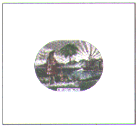
|
Second Official
State Flag - 1868-1900
The Constitutional
Convention of 1868 provided Florida with its second official flag.
It declared that the legislature should, as soon as convenient, "adopt
a State Emblem having the design of the Great Seal of the State impressed
upon a white ground of six feet six inches fly and six feet deep." |

|
Current Official
State Flag - 1900-present time
During the late 1890s,
Governor Francis P. Fleming suggested that a red cross be added, so that
the banner did not appear to be a white flag of truce or surrender when
hanging still on a flagpole. |

|
Tribal Miccosukee
Flag - 1962-present time
It is a Miccosukee
belief that life spins in a circle starting in the east and moving to the
north, west and south. The colors of the Miccosukee flag represent
these four points of the compass. East is represented by the color
yellow, north by red, west by black, and south by white. The Miccosukee
Tribe adopted this flag in 1962. |

|
The Seminole
Tribe of Florida - 1979-present time
The Seminole Tribe
of Florida's flag features the four traditional colors of the Seminole
and Miccosukee people. The central seal, with its fire and open,
palm-thatched hut, called a chickee, represents the tribal council. |
 Links
- Links
-
Florida's
role in the Confederacy
Florida
Kids Home Page
SS
Tarpon
My
Florida.com
Beth's
- My Florida
Swampy
Lou's Florida Homestead
Jarah's
- Florida Cracker And Proud Of It!
-
Back
-

*******

Please
sign our guestbook

*******
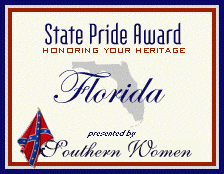
WebMasters:
Want to join your website?
Please click
here

You
are listening to "Swanee River "
|
